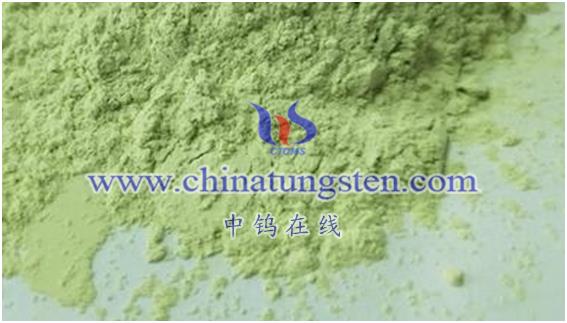
Nano-WO3 has a large specific surface area and significant surface effect. It is a good catalyst, which can be used as a main catalyst and a co-catalyst, and has a high selectivity for the reaction. WO3 has a strong ability to absorb electromagnetic waves and can be used as an excellent solar energy absorbing material and recessive material. WO3 is an n-type semiconductor material with excellent gas sensitivity and sensitivity to NOx. HS, NH, H2, O3 and other gases, so it can be used to make gas sensors and gas-chromic devices.
The bandgap energy of tungsten trioxide is about 2.5eV, and it has potential photocatalytic ability in visible light with wavelength < 500nm. WO3 has potential application prospects in the treatment of organic dye polluted water.
With the development of industrial and agricultural modernization, timely and accurate detection, prediction and automatic control of flammable, explosive, poisonous and harmful gases have become an important issue to be solved urgently in coal, petroleum, chemical, electric power and other departments. A gas sensor is a device that converts information about the type of gas and its concentration into electrical signals. According to the strength of these electrical signals, information related to the existence of the gas to be measured in the environment can be obtained, so that detection, monitoring, and alarm can be performed; an automatic detection, control, and alarm system can also be formed through an interface circuit and a computer.
Tungsten trioxide (WO3) is a wide-bandgap n-type semiconductor, and its excellent sensitivity and selectivity make it an important metal oxide gas-sensing material. The WO3 sensor was first used to detect H2S and H25. After some scholars first reported that the coating of WO3 sinter had good selectivity to extremely low concentration of NOx in 1992, other researchers obtained high sensitivity and high sensitivity by adding noble metals (Pd, Pt, Au) to it. Selective WO3 gas-sensing material prepares a sensor with a faster response to NOx. Nano-tungsten trioxide has the following application fields in gas sensing:
(1) It is used for flammable gas leakage alarm and humidity sensor. The measured gases mainly include CO, CH4, H2, NH3, NO2, SO2, etc., which are mainly used in environmental monitoring.
(2) In terms of civil use, it can detect the leakage of civil gas such as natural gas, petroleum liquefied petroleum gas and city gas, and the gas generated when food is cooked in the microwave oven, so as to automatically control the cooking of food in the microwave oven. smell of gas.
(3) In terms of industry, it is used to detect highly toxic gases such as carbon dioxide, nitrogen oxides, and sulfur oxides in the petrochemical industry; to detect hydrogen generated during the deterioration of power transformer oil; to detect the freshness of perishable foods such as meat; It can also detect the concentration of ethanol gas in the driver’s breath in road traffic, so as to prevent drunk driving and reduce traffic accidents.
With the development of science and technology and the progress of society, the content of refractory organic matter in the air and wastewater is increasing continuously, which seriously threatens human health, which has aroused people’s great attention. With the growing awareness of environmental protection and resource recycling, more and more researches have been done on the degradation of organic pollutants. Photocatalytic degradation of organic matter is a new technology, which uses sunlight to degrade organic matter, saves energy and does not pollute the environment, and has great application prospects.
There are many types of n-type semiconductors as photocatalysts, such as TiO2, ZnO, Fe2O3, CdS and WO3. Studies have shown that WO3 has good photocatalytic stability and has an ideal catalytic effect on photocatalytic degradation of pollutants in water. Moreover, my country’s tungsten reserves are abundant, ranking first in the world, and WO3 has a wide range of sources.
Nano-tungsten trioxide mainly has the following applications in photocatalysis:
(1) Application in the field of air purification
The photocatalytic technology in the field of air purification means that photocatalysis can directly use oxygen in the air as an oxidant, effectively decompose indoor and outdoor organic pollutants, oxidize and remove nitrogen oxides, sulfides and various odors in the atmosphere, and The reaction conditions are mild, and it is a very convenient air purification technology.
(2) Application in medical wastewater
With the rapid development of the pharmaceutical industry, while bringing huge economic benefits, the pollution of the discharged wastewater to the environment is also increasing. Medical wastewater has high concentration of organic matter, poor biodegradability, deep color, and complex components. It contains pollutants such as petroleum, amines, and acid demulsifiers. It is a refractory organic wastewater that brings unpredictable impacts and hazards to the ecosystem. ah. Therefore, in recent years, there are more and more researches on the degradation of organic pollutants by photocatalytic oxidation at home and abroad.
(3) Application in wastewater treatment
In 1985, some scholars first reported the experiment of using WO3 as a photocatalyst to treat printing and dyeing wastewater. The results showed that when visible light irradiated semiconductor powder suspended in an aqueous solution, the dyes were decomposed into CO2, H2O, N2, etc., thereby reducing COD. and chroma. In order to improve the removal rate of COD and chroma of printing and dyeing wastewater, appropriate amount of CdS and a small amount of metal W powder can be mixed into the matrix WO3. The advanced treatment of wastewater was carried out by using the multiphase photocatalyst WO/CdS/W.
More details of tungsten oxide product, please visit website: tungsten-oxide.com
Please contact CHINATUNGSTEN for inquiry and order of tungsten oxide:
Email: sales@chinatungsten.com
Tel.: 86 592 5129595






